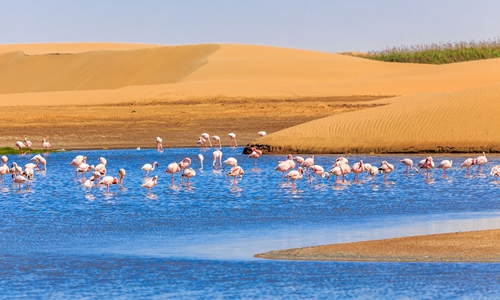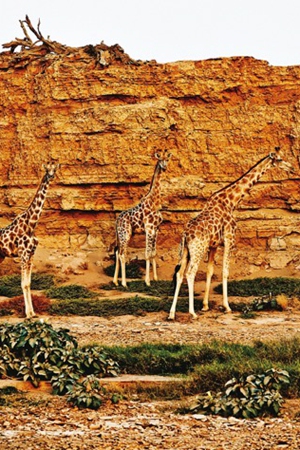Namibian tourism industry strives to meet challenge of COVID-19
Source:Xinhua Published: 2020/4/16 22:38:41

A flock of pink flamingos march along a dune in the Kalahari Desert, Namibia. Photo: IC

A herd of giraffes near Hoanib Camp, Namibia Photo: VCG
The COVID-19 pandemic is adversely impacting the Namibian travel and tourism industry, which is experiencing a slowdown of business activities. Tourism is a major industry in the country.
Namibia is a popular destination for international visitors. More than 1.5 million tourists visited Namibia in 2018, an increase from 1.49 million visitors recorded in 2017, shows the 2018 Tourist Statistical Report published by the Ministry of Environment, Forestry and Tourism.
Theunis Keulder, manager of Catamaran Charters in Namibia's coastal Erongo region, said that clients at his business had declined drastically.
Activities and services such as quad biking, cultural tours, sandboarding, boat cruises and accommodation bookings among others have come to a halt.
"Amid the COVID-19 outbreak, which resulted in a travel ban and lockdown, tourists are not coming into the country while locals stay home, which has negatively impacted our operations. This is catastrophic for the tourism sector in Namibia," Keulder said.
Keulder is not the only one. Before the COVID-19 outbreak, businessman Fred Fredricks' boat cruise enterprise was thriving. On a good month, it could generate up to N$800,000 ($44,000). But things have since changed.
"Since the outbreak, about 200 clients canceled their bookings for excursions initially scheduled for the Easter weekend in April, driving the business to a slump," said Fredricks.
Gloomily, the slowdown and business activities stoppage has subsequently led to income and job losses, in particular, for tour consultants and employees.
Andreas Namene, a tour consultant at Sunsail Catamaran, said that the COVID-19 outbreak has negatively affected the business.
"Business is not as prosperous as we are not generating any income. I don't know how we will cope without any excursions or rendering any services," he said.
Furthermore, the informal sector traders relying on tourists are equally thwarted.
David Sikongo sold handmade art pieces and crafts to international and local travelers at public space at the coast.
Shikongo's trade, which heavily relied on tourists, has suffered great loses since the COVID-19 outbreak.
"Not only are the tourist not coming anymore, but I cannot trade either due to the lockdown. We don't know how we will make ends meet. I hope the government helps us. I cannot fathom the implications of COVID-19 on our effort," Sikongo said on April 9.
A recent report by the African Union has noted that COVID-19 will have a high impact on Africa's tourism industry.
At home, the significant slump in the tourism industry amid the COVID-19 pandemic does not only impact major tourism source markets, but also the wider Namibian economy.
Officials say that the losses are attributed to the elimination of human factor and presence, essential for business transactions in the industry.
"One can only earn the cash or income once a tourist has consumed a product. As such, the lack of activities or presence of clients has resulted in cash flow problems for businesses and people in the tourism industry amid the cancellations and travel bans," said Digu Naobeb, chief executive officer of Namibia Tourism Board.
The tourism sector is estimated to lose about N$2 billion during the COVID-19 pandemic.
In the meantime, the sector is looking to exploring ways to withstand the challenges.
According to Naobeb, key stakeholders are deliberating on mitigating factors to sustain business activities in the tourism sector.
These include stepping up the recommended sanitation and hygiene measures as well as through partnerships. Industry players are also in talks to promote domestic travels.
"This would be another measure to cushion this, by offering incentives for locals," Naobeb added.
In the interim, tourism enterprises such as that run by Keulder are maximizing on the lockdown period to re-strategize and re-model their business positioning.
Namibia has recorded 16 confirmed cases of COVID-19.
Newspaper headline: ToughTimes
Posted in: BANNER-NEWS